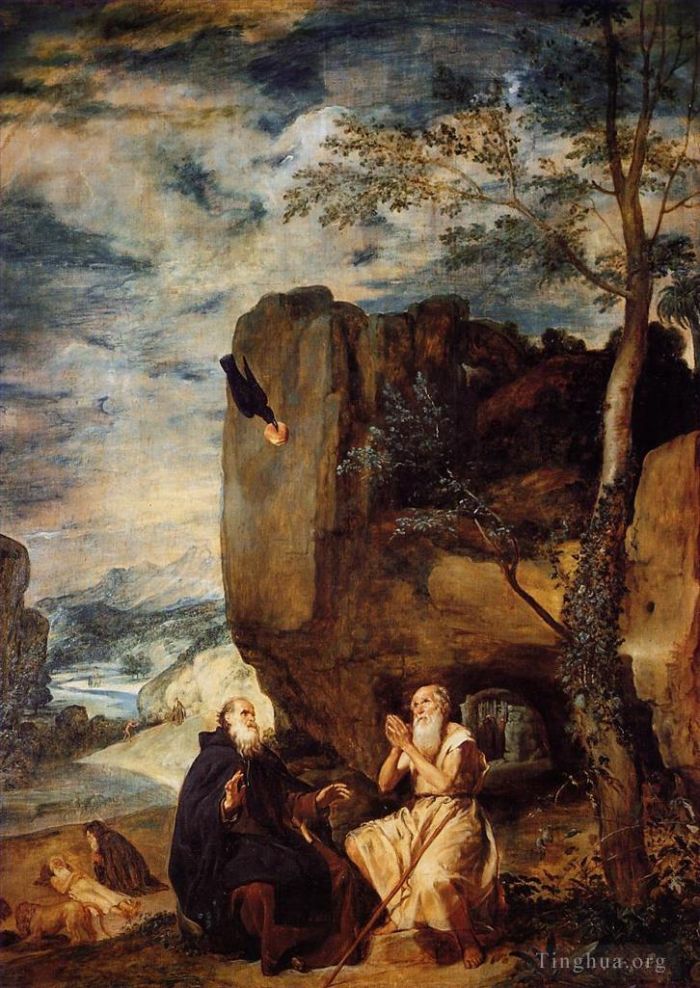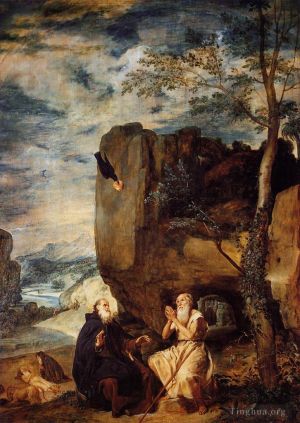Saint Anthony Abbot and Saint Paul the Hermit
Diego Velazquez
- Price: Price on Request
- Art Type: Oil Painting
- Size:
- English Comments: 0
- International Comments: 0
- Creating Date:
- Introduction and Works of Diego Velazquez >>
Work Overview
- Saint Anthony Abbot and Saint Paul the Hermit
Diego Velázquez
Ca. 1634
Oil on canvas
261 x 192.5 cm
The subject is drawn from the narration in Jacobo de la Voragine`s 13th-century Golden Legend of Saint Anthony the Abbot`s voyage to the Egyptian desert to visit Saint Paul, the first Christian hermit (4th century). Saint Anthony, whom Velázquez presents dressed in the black-hooded, brown habit of the Hospitallers of Saint Anthony, appears five times in the painting. In the background, he asks his way from a centaur and also converses with a satyr. In a hollow among boulders that recall Patinir`s huge, rocky Landscape with Saint Jerome (already in the Royal Collection at that time, and now at the Museo del Prado), he is depicted knocking on the holy Anchorite`s door. In the foreground, he converses with Saint Paul and is surprised by the raven that brings Paul his daily bread. The final episode is shown at the left: after hearing that Paul has died, he discovers two lions digging the hermit`s tomb.
Velázquez based his depiction of the two saints` meeting on Dürer`s engraving of the same subject, although he must also have known Sánchez Coello`s painting for one of the two altars at the basilica of El Escorial. In his consideration of possible visual sources for this work, Diego Angulo (1946) observed that the breadth of the setting and the valley`s pale blue lighting recall the landscape of northern Madrid and were Velázquez`s own contribution. More recently (Brown), parallels have been drawn with frescoes of Roman landscapes by Pietro da Cortona at the Villa Sacchetti in Castelfusano, which Velázquez may have seen in 1630-1631. The application of a very thin coat of paint over a light-colored base generates notably luminous and translucent effects. Various pentimenti are clearly visible, for example, in the figure of Saint Paul and in Saint Anthony`s crosier. The top of this work originally ended in a semicircular arch (the two upper corners were added and painted when the canvas was lined, possibly in the 19th century), indicating that it was conceived for an altar. It was probably commissioned for the hermitage of San Pablo -one of several constructed in the gardens of Madrid`s buen Retiro Palace- whose altarpiece, now lost, was completed in May 1633 and included a sculpture of Saint Paul the Hermit by Italian artist Giovanni Antonio Ceroni. First documented in the hermitage of San Antonio de los Portugueses in 1701, this painting may have been moved there when the hermitage of San Pablo was renovated and redecorated between 1659 and 1661 (Text from Finaldi, G.: Fábulas de Velázquez. Mitología e Historia Sagrada en el Siglo de Oro, Museo Nacional del Prado, 2007, pp. 323-324).
- Copyright Statement:
All the reproduction of any forms about this work unauthorized by Singing Palette including images, texts and so on will be deemed to be violating the Copyright Laws.
To cite this webpage, please link back here.
- >> English Comments
- >> Chinese Comments
- >> French Comments
- >> German Comments
- >>Report
- Philip IV
- View of the Gardens of the Villa Medici Rome
- Buffoon Barbarroja
- Pope Innocent X
- Don Luis de Gongora y Argote
- The Surrender of Breda
- Three Musicians aka Musical Trio
- Lady with a Fan
- Two Young Men at a Table
- Old Woman Frying Eggs
- Prince Felipe Prospero
- The Infanta Don Margarita de Austria
- The Toilet of Venus (Venus at her Mirror or The Rokeby Venus)
- Queen Isabel
- Mpther Jeronima de la Fuente
- De Acedo El Primo
- Pablo de Valladolid
- Philip IV in Brown and Silver
- Philip IV Standing
- Philip IV as a Hunter
- Juan de Pareja
- A Dwarf Holding a Tome in His Lap aka Don portrait Diego de Acedo el Primo
- Innocent X
- Young Man 1629
- The Poet Don Luis de Gngora y Argote
- Infante Don Carlos
- Sebastian de Morra
- Democritus
- Infante Philip Prosper dog
- Cardinale Ferdinand
- Portrait of a Man
- The Spinners (The Fable of Arachne)
- The Buffoon Calabazas2
- Philip IV 1624
- Philip IV Standing2
- Saint Paul
- Portrait of the Infanta Margarita
- Vulcan’s Forge
- Philip IV at Fraga
- Infante Philip Prosper
- Portrait of a Little Girl
- Head of a Deer
- Don portrait Diego del Corral y Arellano
- Portrait of a Man with a Goatee
- King Philip IV as a Huntsman
- Miguel Angelo Barber to the Pope
- Court Dwarf Don Antonio el Ingles
- Jester Don Juan de Austria
- The Buffoon Juan de Austria
- The Lunch (Luncheon or Breakfast)
- Young Peasant Girl
- The Temptation of St Thomas Aquinas
- St Ildefonso Receiving The Chasuble From The Virgin
- The Dwarf Francisco Lezcano
- Mercury and Argus
- Portrait of Innocent X
- A Sibyl
- Dona Antonia de Ipenarrieta y Galdos with Her Son
- Las Meninas
- The needlewoman
- Camillo Massimi
- Don Gaspar de Guzman Count of Olivares and Duke of San Lucar la Mayor
- Self
- A Dwarf Sitting on the Floor
- Queen Isabel Standing
- Prince Baltasar Carlos in Hunting Dress
- Supper at Emmaus
- John at Patmos
- Portrait of a Cleric
- Dona Antonia de Ipenarrieta y Galdos and her Son Luis
- Don Cristobal Suarez de
- Philip IV In Armour 1628
- Study For The Head Of Apollo
- Menippus
- Abbess Jeronima de la Fuente
- Francesco II dEste Duke of Modena
- Aesop
- A Young Lady
- Portrait of a Young Man 1626
- Francisco Bandres de Abarca
- Juan Martinez Montanes
- Queen Dona Mariana of Austria
- Josephs bloody coat
- Christ in the House of Mary and Marthe
- Philip IV on Horseback
- 4Velazquez Portrait of the Infanta Margarita
- The Buffoon Pablo de Valladolid
- View of Zaragoza
- Mars
- Maria Teresa of Spain with two watches
- Don Juan Mateos
- Dona Maria de Austria
- Don Gaspar de Guzman Count of Oliveres and Duke of San Lucar la Mayor2
- The Feast of Bacchus (The Triumph of Bacchus or Los borrachos)
- Portrait of Philip IV
- Sibyl
- Saint John at Patmos
- Don Baltasar Carlos with a Dwarf
- The Buffoon Don Cristobal de Castaneda y Pernia aka Red Beard
- The Buffoon Calabazas
- A Knight of the Order of Santiago
- Don Balthasar Carlos
- Saint Anthony Abbot and Saint Paul the Hermit
- THe Waterseller of Seville
- The Farmers Lunch (Peasants at the table)
- Infanta Marguarite Therese
- Prince Baltasar Carlos on Horseback
- Kitchen Scene With The Supper In Emmaus
- The crucified Christ
- The Adoration of the Magi
- Archne A Sybil
- The Sculptor Martinez Montanes
- The Coronation of the Virgin
- Velasquez2
- The Dwarf Don Juan Calabazas called Calabacillas
- Los Borrachos The Triumph of Bacchus
- Allegorical Portrait of Philip IV
- Cardinal Camillo Astalli
- The White Horse
- The Immaculate Conception
- Velasquez1
- Head Of A Girl
- Gaspar de Guzmán Count-Duke of Olivares on Horseback









 Singing Palette
Singing Palette